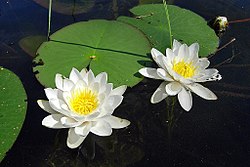Nymphaea candida: Difference between revisions
Created page with '{{SPlantbox |genus=Nymphaea |species=candida |Temp Metric=°F |jumpin=If this plant info box on watering; zones; height; etc. is mostly empty you can click on the edit tab and f…' |
No edit summary |
||
| Line 1: | Line 1: | ||
{{SPlantbox | {{SPlantbox | ||
|genus=Nymphaea | |familia=Nymphaeaceae | ||
|genus=Nymphaea | |||
|species=candida | |species=candida | ||
|taxo_author=J. Presl | |||
|Temp Metric=°F | |Temp Metric=°F | ||
|jumpin=If this plant info box on watering; zones; height; etc. is mostly empty you can click on the edit tab and fill in the blanks! | |jumpin=If this plant info box on watering; zones; height; etc. is mostly empty you can click on the edit tab and fill in the blanks! | ||
|image= | |image=Lumme (Nymphaea candida).JPG | ||
|image_width=240 | |image_width=240 | ||
}} | }} | ||
'''''Nymphaea candida''''' J. Presl is a species of [[aquatic plant|aquatic]] [[perennial plant|perennial]] [[herbaceous]] plants in the genus ''[[Nymphaea]]'' native to quiet freshwater habitats in [[Eurasia]], it is in flower from July to August. It is sometimes treated as a [[subspecies]] of ''[[Nymphaea alba|N. alba]]'' (''N. alba'' L. subsp. ''candida'' (J. Presl) Korsh.). | |||
{{Inc| | {{Inc| | ||
Nymphaea candida, Presl (N. biradiata, Somm. N. semiaperta, Klinggraef. N. alba minor, DC. N. nitida, Sims?). Similar to No. 24: line of insertion of the sepals angular, projecting downward: lowest pair of veins of lf. (veins of the lobes) curved toward one another: all of the filaments broader than their anthers: fr. ovoid; seed large. Cent, and N. Eu. | Nymphaea candida, Presl (N. biradiata, Somm. N. semiaperta, Klinggraef. N. alba minor, DC. N. nitida, Sims?). Similar to No. 24: line of insertion of the sepals angular, projecting downward: lowest pair of veins of lf. (veins of the lobes) curved toward one another: all of the filaments broader than their anthers: fr. ovoid; seed large. Cent, and N. Eu. | ||
Latest revision as of 18:38, 22 February 2010
| Nymphaea candida subsp. var. | ||||||||||||||||||||||||||||||||||||||||||||||||||||||||
|---|---|---|---|---|---|---|---|---|---|---|---|---|---|---|---|---|---|---|---|---|---|---|---|---|---|---|---|---|---|---|---|---|---|---|---|---|---|---|---|---|---|---|---|---|---|---|---|---|---|---|---|---|---|---|---|---|

|
|
| ||||||||||||||||||||||||||||||||||||||||||||||||||||||
| ||||||||||||||||||||||||||||||||||||||||||||||||||||||||
Nymphaea candida J. Presl is a species of aquatic perennial herbaceous plants in the genus Nymphaea native to quiet freshwater habitats in Eurasia, it is in flower from July to August. It is sometimes treated as a subspecies of N. alba (N. alba L. subsp. candida (J. Presl) Korsh.).
| Standard Cyclopedia of Horticulture |
|---|
|
Nymphaea candida, Presl (N. biradiata, Somm. N. semiaperta, Klinggraef. N. alba minor, DC. N. nitida, Sims?). Similar to No. 24: line of insertion of the sepals angular, projecting downward: lowest pair of veins of lf. (veins of the lobes) curved toward one another: all of the filaments broader than their anthers: fr. ovoid; seed large. Cent, and N. Eu.
|
Cultivation
Propagation
Pests and diseases
Varieties
Gallery
-
photo 1
-
photo 2
-
photo 3
References
- Standard Cyclopedia of Horticulture, by L. H. Bailey, MacMillan Co., 1963
External links
- w:Nymphaea candida. Some of the material on this page may be from Wikipedia, under the Creative Commons license.
- Nymphaea candida QR Code (Size 50, 100, 200, 500)
